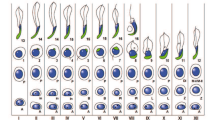Abstract
IT was pointed out previously that in the unstained living human spermatid the Golgi apparatus is sometimes discernible with bright-ground illumination, as an area slightly differing in refractive index from the remainder of the cytoplasm1. Recently, I have been able to confirm and extend these observations with the phase-contrast microscope. This instrument was of the phase-accelerating or positive type, so that dark and light regions in the image indicated higher and lower refractive indices, as a rule.
Similar content being viewed by others
References
Oettlé, A. G., S. Afr. J. Sci., 37, 239 (1940).
Gatenby, J. B., and Beams, H. W., Quart. J. Mic. Sci., 78, 1 (1936).
Baker, J. R., Quart. J. Mic. Sci., 85, 1 (1944).
Author information
Authors and Affiliations
Rights and permissions
About this article
Cite this article
OETTLÉ, A. Golgi Apparatus of Living Human Testicular Cells Seen with Phase-Contrast Microscopy. Nature 162, 76–77 (1948). https://doi.org/10.1038/162076a0
Issue Date:
DOI: https://doi.org/10.1038/162076a0
- Springer Nature Limited
This article is cited by
-
Cytoplasmic organelles in the male germ-cells of Vaginula maculata (pulmonata, mollusca)
Zeitschrift f�r Zellforschung und Mikroskopische Anatomie (1954)
-
Das Phasenkontrastmikroskop in medizinischer Forschung und Diagnostik
Klinische Wochenschrift (1952)





